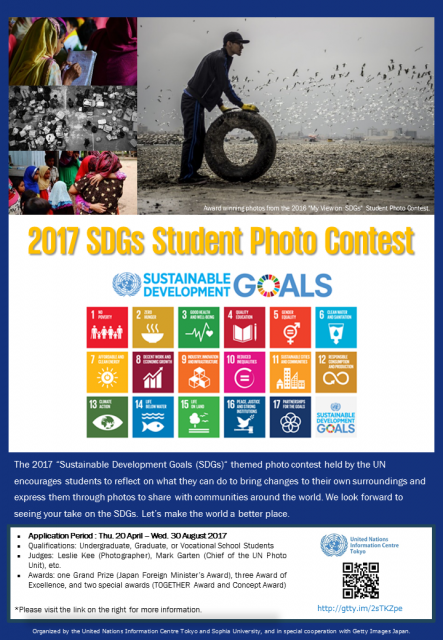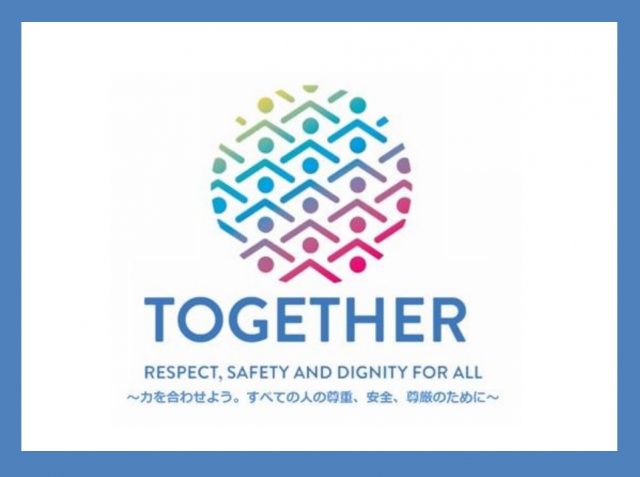
The United Nations Information Centre, Tokyo (UNIC Tokyo) and Sophia University are, once again, co-organizing the student photo contest on SDGs with special cooperation from Getty Images Japan. The first photo contest was launched in Japan last year, amassing a total of 624 entries from 47 countries as far and wide as Afghanistan and Brazil. We welcome presently enrolled college and university students, graduate students, and vocational school students to apply.
We ask that you choose one or more of the 17 SDGs that interest you most, and express what it means to you through a photo snapshot. We particularly encourage entries that depict elements of SDGs in your own community. A theme pertaining to the SDGs must also exist within your own country. This year, we will be having the TOGETHER Award and the Concept Award as new additions to the list of awards.
Please visit the contest site at:
https://communityassignments.gettyimages.com/en/community-assignments/sdgs_2017/![[別窓]](http://www.unic.or.jp/common/img/icon_external_link01.png)
https://communityassignments.gettyimages.com/en/community-assignments/sdgs_2017/
Contest Details:
This contest aims to encourage students to “reflect on sustainable development from his or her own perspective, express it through a photo, and share it with others.” We welcome photos that tell a story; they may come in a journalistic form, presenting a clear problem, or may be abstract and creative, representing your ideas and thoughts. What can you do to change the world? How will the SDGs influence the way you think or act? How can you inform your friends, family, and community members of social issues and prompt them to take action? The answers to these questions will become key to achieving the SDGs. We hope you will take advantage of this opportunity and apply.
Last year’s prize winning entries can be viewed at:
https://communityassignments.gettyimages.com/en/community-assignments/sustainabledevelopment/![[別窓]](http://www.unic.or.jp/common/img/icon_external_link01.png)
https://communityassignments.gettyimages.com/en/community-assignments/sustainabledevelopment/
"Application Details
❖ Deadline: Submit your photo(s) between Thursday 20 April and Wednesday 30 August 2017. The announcement of the results and the awards ceremony is scheduled to be held in conjunction with United Nations Day, on 24 October.
❖ Qualifications: Applicants must be presently enrolled in university – college and undergraduate students, graduate students, or vocational school students (We welcome entries from applicants of any nationality, including those living abroad)
❖ Awards (subject to change depending on the content and number of applications):
・Grand Prize (Foreign Minister’s Award) 1 Prize
・Award of Excellence 3 Prize
・Special Award (TOGETHER Award) 1 Prize
・Special Award (Concept Award) 1 Prize
・Award of Recognition
❖ Judges:
Leslie Kee, Photographer
Akira Ono, Photo and Multimedia Editor, The Asahi Shimbun
Yuichi Kimura, Comedian, YOSHIMOTO CREATIVE AGENCY CO., LTD.
Hiroaki Mizushima, Professor, Department of Journalism, Sophia University
Mark Garten, Chief of the UN Photo Unit, Audio-Visual Services Section, United Nations Department of Public Information (DPI)
❖ Judging Panel for the TOGETHER Award:
Representatives from the International Labour Organization (ILO), International Organization for Migration (IOM), United Nations High Commissioner for Refugees (UNHCR), UNIC Tokyo, United Nations Children’s Fund (UNICEF), and United Nations University (UNU)
❖ Judge for the Concept Award:
Getty Images Japan (evaluating based on how well the photograph represents the concepts of the SDGs and evokes certain messages or emotions)
❖ Organisers: UNIC Tokyo, Sophia University
❖ Special Cooperation: Getty Images Japan
❖ Endorsed by: Ministry of Foreign Affairs of Japan, Global Compact Network Japan (GC-NJ),Japan International Cooperation Agency (JICA) and Japan Civil Society Network on SDGs
❖ Cooperating Partners: Fast Retailing Co., Ltd., Nikon Corporation, SIGMA Corporation
❖ Media Partner: The Asahi Shimbun
❖ Prize Money and Goods: presented by organisers, special cooperating partner, and other cooperating partners (Details will be available on the official contest website)"
Sustainable Development Goals (SDGs)
 TOGETHER campaign
TOGETHER campaign'via Blog this'あなたも応募して 世界につながろう! 「持続可能な開発目標(SDGs)学生フォトコンテスト2017」 作品募集中! | 国連広報センター:





